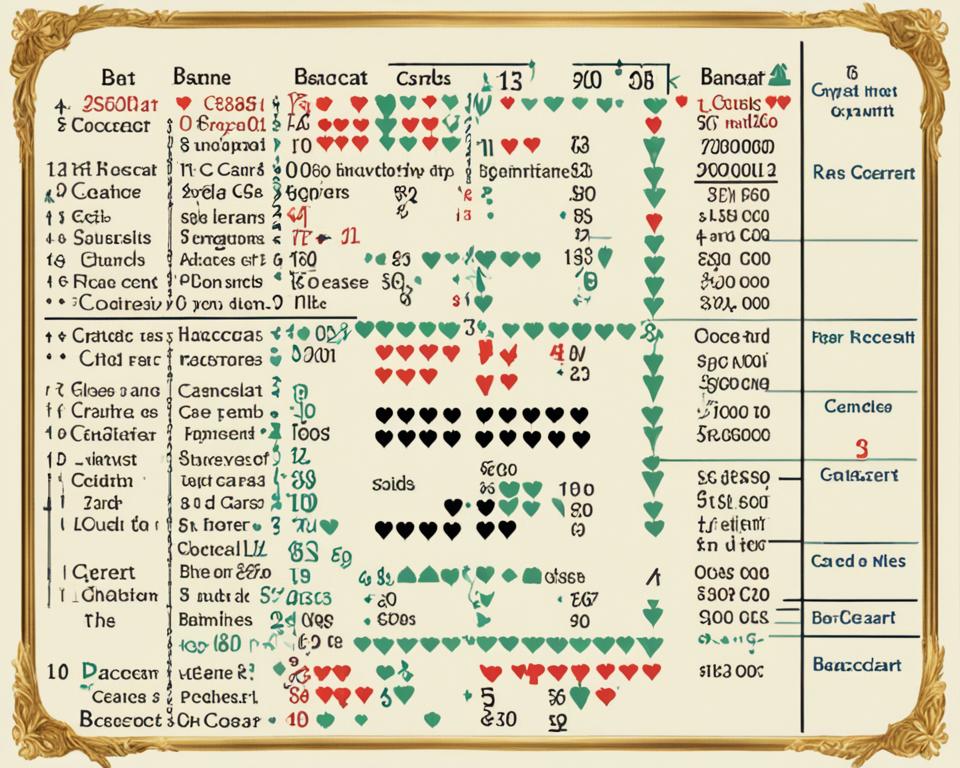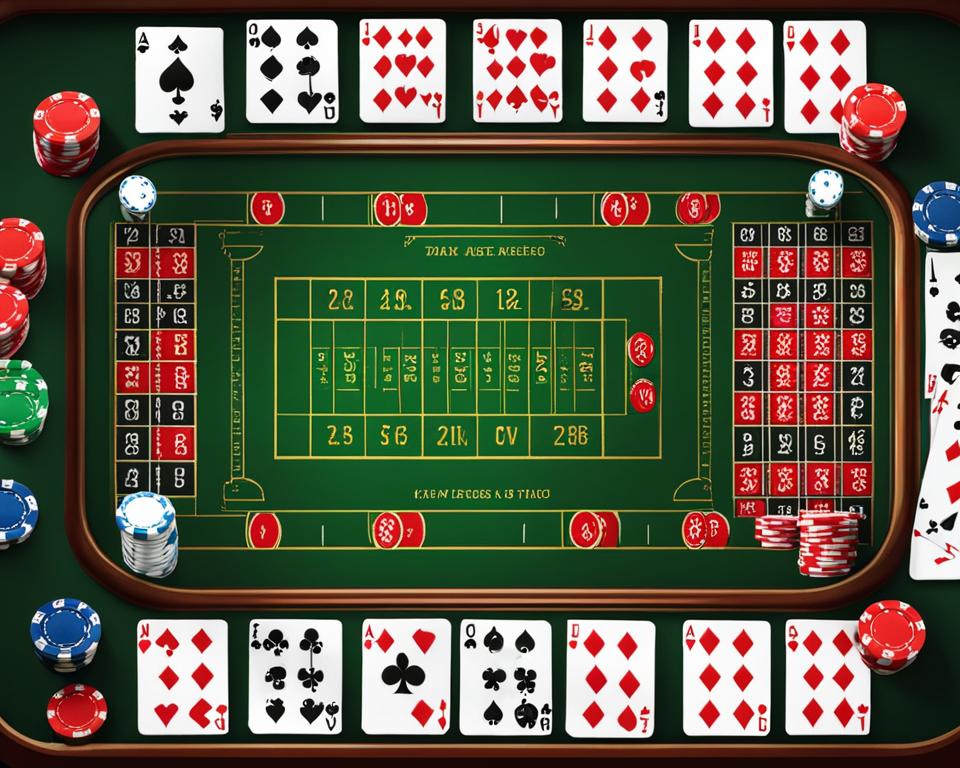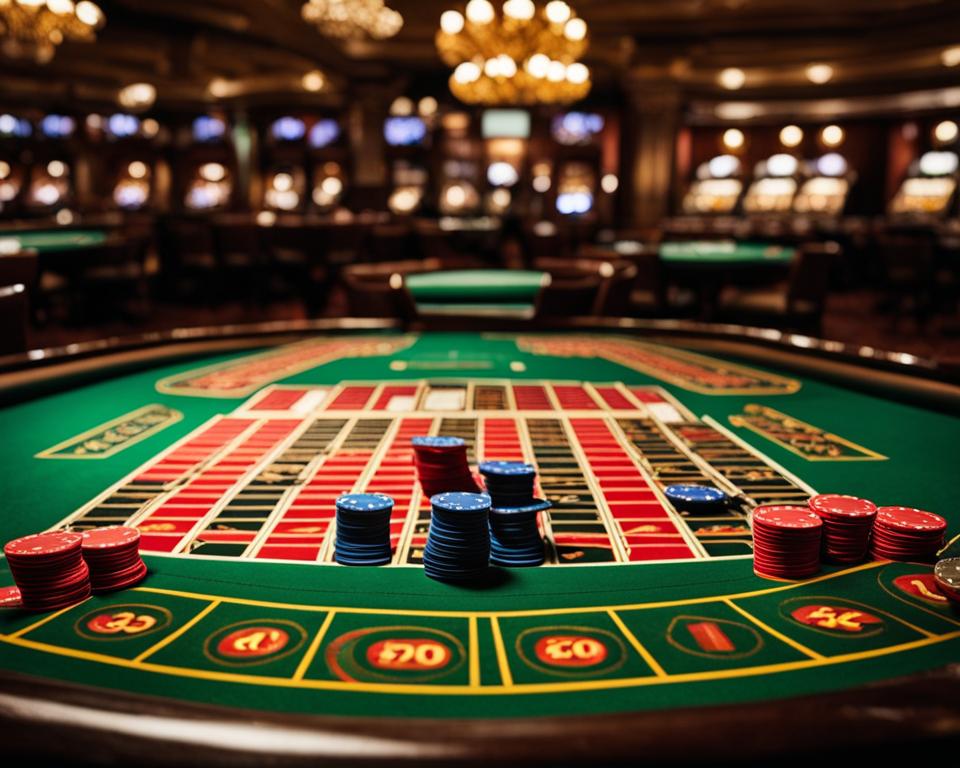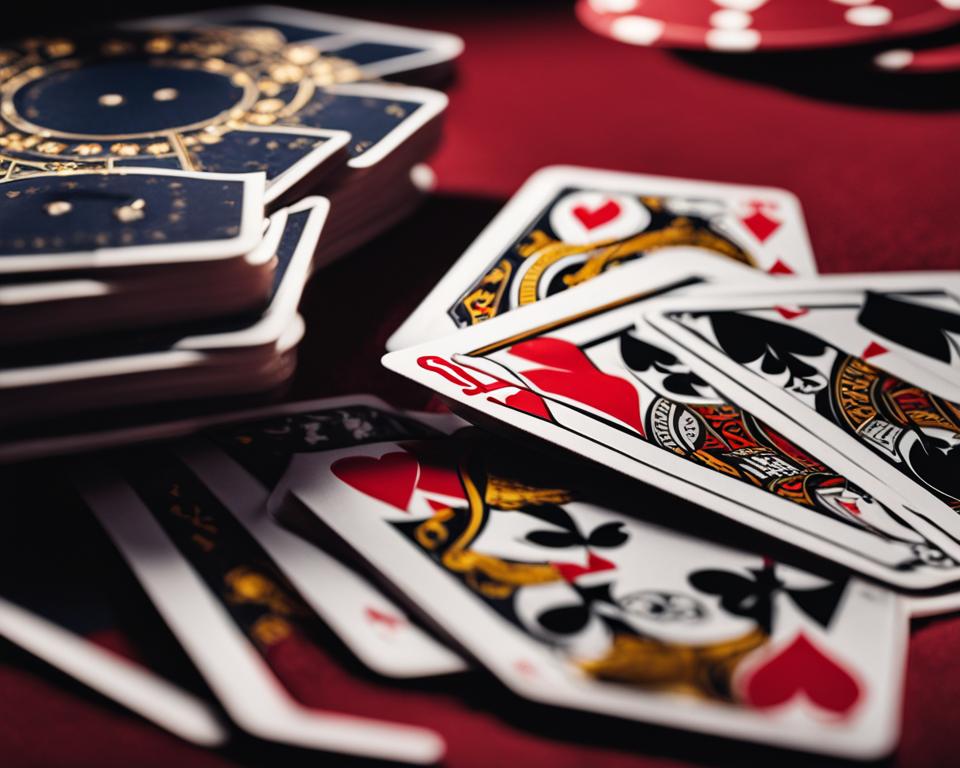Welcome to our beginner’s guide to Baccarat! If you’re new to this classic casino game, you’re in the right place. Baccarat is a simple and exciting card game that is perfect for those who want to try their luck at the tables.
In Baccarat, players bet on one of two hands: the player or the banker. The goal is to have a hand total as close to 9 as possible. Each card has a value, where 2 through 9 have their face value, face cards and 10s have no value, and Aces are worth 1. The dealer handles all the cards, so all you need to do is make your bet and hope for a winning hand.
Whether you’re a complete novice or just need a refresher, this guide will walk you through the rules of Baccarat step by step. By the end, you’ll be ready to join the table with confidence and enjoy the excitement of this elegant card game.
Key Takeaways:
- Baccarat is a simple casino card game where players bet on either the player or the banker hand.
- The goal is to have a hand total that is as close to 9 as possible.
- Face cards and 10s have no value, while Aces are worth 1.
- The dealer does all the work, and players simply place their bets and watch the outcome.
- By understanding the rules of Baccarat, you can confidently join a game and enjoy the thrill of this classic casino game.
How To Bet On Baccarat
In the game of Baccarat, players have the option to place their bets on either the player side or the banker side. The rules of Baccarat are straightforward, and the dealer takes care of handling the cards. As a player, all you need to do is make your choice and wait to see how the game unfolds. The objective of Baccarat is to have a hand total that is as close to 9 as possible.
When playing Baccarat, you can follow these simple steps to place your bets:
- Decide whether you want to bet on the player or the banker side.
- Inform the dealer of your chosen bet.
- Wait for the dealer to place the cards on the designated positions for the player and banker hands.
- See how the cards are revealed and determine the hand total.
- The hand with a total closest to 9 wins the round.
To illustrate Baccarat’s gameplay, here’s an image showing the setup of a Baccarat table:
As you can see, the table provides separate areas for the player and banker bets, making it clear where you should place your chips to indicate your wager. The simplicity of Baccarat makes it an accessible game for beginners and experienced players alike.
Baccarat is a game of chance where players can enjoy the excitement of anticipation without needing any special skills or strategies. By understanding the basic rules and placing your bets, you can participate in the game and embrace the thrills of Baccarat gameplay.
How To Win Baccarat
When playing Baccarat, the ultimate goal is to have a hand that is closer to 9 than the other hand. Each hand in Baccarat is made up of two cards, and the values of these cards are added together. It’s important to understand the values assigned to each card.
- Face cards (King, Queen, Jack) and 10s have no value
- All other cards have their face value
If the total value of the hand exceeds 9, the second digit becomes the value of the hand. For example, if the total is 15, the value of the hand becomes 5. Let’s take a closer look at an example:
A player is dealt a 5 and an 8, resulting in a total of 13. Because the total is greater than 9, the hand value is 3.
In Baccarat, both the player and the banker have the opportunity to win. It’s essential to understand the rules regarding which hand wins in different scenarios:
- If the player’s hand is closer to 9 than the banker’s hand, the player wins.
- If the banker’s hand is closer to 9 than the player’s hand, the banker wins.
- In the event of a tie, neither the player nor the banker wins, unless a tie bet was placed.
| Baccarat Hand Value | Result |
|---|---|
| 0 – 9 | The hand with the higher value wins. |
| 8 or 9 | Natural win, no additional cards are drawn. |
| 6 or 7 | The player and banker stand, no additional cards are drawn. |
| 4 or 5 | The player can draw a third card, depending on the banker’s hand. |
| 0 – 3 | The player always draws a third card. |
Baccarat Quote:
“Understanding the card values and the rules for determining the winning hand is crucial in Baccarat. By grasping these basics, players can increase their chances of success and enjoyment in this classic casino game.”
Baccarat Score Card
During a game of Baccarat, it is important to keep track of the hand totals to understand the progress and make informed decisions. Baccarat score cards are commonly used by both players and dealers to monitor the score as the cards are dealt. They provide a visual representation of the ongoing game and help players strategize their bets.
Using a Baccarat score card is simple and straightforward. Each card that is dealt is recorded on the score card according to its value. The cards are typically represented by their numerical value, such as “2” for a 2, “3” for a 3, and so on. Face cards and 10s are usually represented by “0” since they hold no value in the game. A score card may look like this:
The score card allows players to easily keep track of the hand totals for both the player and the banker as the game progresses. It provides a quick reference to determine which side is closer to 9 and can help in decision-making for subsequent bets.
Aside from its practical purpose, score cards can also serve as a canvas for doodling or writing notes. Players may jot down observations, strategies, or even lucky numbers. It adds a personal touch to the game and can make the Baccarat experience more enjoyable.
Baccarat Drawing Rules
In Baccarat, understanding the drawing rules is crucial for both players and bankers. These rules determine when a third card is drawn and can significantly impact the outcome of the game.
Player’s Third Card Rule
When it comes to the player’s hand, the drawing rule is relatively straightforward. If the player’s hand has a total of 0-5, they must draw a third card. However, if the total is 6 or 7, the player stands and does not draw a card. Finally, if the player’s hand value is 8 or 9, it’s considered a natural and automatically wins, with no additional cards drawn.
Banker’s Third Card Rule
Unlike the players, the banker’s decision to draw a third card is more complex. The banker’s action is dependent on two factors: the player’s total and specific conditions outlined in the drawing rules.
If the player stands and does not draw a third card, the banker’s actions are as follows:
- If the banker’s hand total is 0-2, the banker always draws a third card.
- If the banker’s hand total is 3 and the player’s third card is anything other than an 8, the banker draws a card.
- If the banker’s hand total is 4 and the player’s third card is between 2 and 7, the banker draws a card.
- If the banker’s hand total is 5 and the player’s third card is between 4 and 7, the banker draws a card.
- If the banker’s hand total is 6 and the player’s third card is either a 6 or a 7, the banker draws a card.
- If the banker’s hand total is 7, the banker stands and does not draw a card.
These drawing rules for the banker are followed to determine whether a third card is necessary to complete the hand. The goal is to have a hand total as close to 9 as possible and beat the opponent’s hand.
To better understand the Baccarat drawing rules, refer to the following table:

Mastering the drawing rules in Baccarat is essential for making informed decisions during gameplay. By familiarizing yourself with these rules, you can maximize your chances of winning and enjoy the excitement of this classic casino game.
Betting House Edge in Baccarat
When it comes to playing Baccarat, understanding the house edge is crucial for making informed bets. The house edge represents the advantage that the casino has over the players. In this section, we will explore the different bets in Baccarat and their corresponding house edge percentages.
Let’s take a closer look at the house edge for each type of bet:
| Bet Type | House Edge |
|---|---|
| Player Bet | 1.06% |
| Banker Bet | 1.24% |
| Tie Bet | 14.36% |
As shown in the table above, the player bet has the lowest house edge at 1.06%, making it the most favorable bet in terms of odds. The banker bet has a slightly higher house edge at 1.24%, but it is still relatively low compared to other casino games. On the other hand, the tie bet has a significantly higher house edge of 14.36%, making it a riskier bet with lower odds of winning.
It’s important to note that the house edge percentages mentioned above can vary depending on the number of decks used in the game. Generally, the fewer decks used, the lower the house edge. So, it’s always a good idea to check the rules of the specific Baccarat game you’re playing to understand the exact house edge for each bet.
Understanding the house edge in Baccarat can help you make more informed decisions while placing your bets. By opting for bets with lower house edges, such as the player or banker bet, you can increase your chances of winning in the long run.
Remember, gambling should always be done responsibly, and it’s essential to set limits and play within your means.
Baccarat Tie and Pairs Bets
In addition to betting on the player or banker, players can also place bets on a tie or pairs in the game of Baccarat. These additional bets offer a chance for players to enhance their gameplay and potentially increase their winnings.
Baccarat Tie Bet:
A tie bet in Baccarat is when a player wagers that the player’s hand and the banker’s hand will have the same total. If the outcome of the game is indeed a tie, the player who placed a tie bet will receive a payout. The payout for a tie bet may vary depending on the casino, but it is usually around 8 to 1 or 9 to 1.
Baccarat Pairs Bet:
A pairs bet in Baccarat is when a player bets that the first two cards dealt to either the player or the banker will be a pair. A pair is formed when the two initial cards have the same value, for example, two 7s or two Queen cards. If the first two cards form a pair, the player who placed a pairs bet will receive a payout. The payout for a pairs bet is typically around 12 to 1.
These additional Baccarat bets provide an opportunity for players to add excitement and variety to their gameplay. However, it is essential to note that these bets carry a higher risk, as the odds of a tie or a pair occurring are relatively lower compared to the player or banker winning. Therefore, players should consider their strategy and bankroll management before placing these additional bets.

| Bet Type | Payout |
|---|---|
| Tie Bet | 8 to 1 or 9 to 1 (varies by casino) |
| Pairs Bet | 12 to 1 |
Baccarat Shoe and Dealing
Baccarat is a thrilling game that utilizes a shoe to distribute the cards and ensure fairness. The shoe used in Baccarat contains eight decks of cards, providing ample opportunities for players to test their luck. As the game progresses, the shoe is passed around the table, making it a collaborative and interactive experience.
One exciting aspect of Baccarat is that each player has the chance to deal the cards. This creates a sense of involvement and control over the game’s outcome. Players eagerly await their turn to hold the shoe and take charge of the card distribution process.
When dealing the cards, the dealer starts by distributing four cards in total, two for the player and two for the banker. The cards are dealt alternately, creating suspense and anticipation with every flip. As the dealer places each card on the table, they announce the total value of the hand, heightening the excitement for the players.
By having the opportunity to deal the cards and witness the distribution firsthand, players feel more engaged and connected to the game. It adds an extra layer of enjoyment and involvement, making Baccarat a unique and captivating casino experience.
Dealing Process in Baccarat:
1. The shoe, filled with eight decks of cards, is passed around the table.
2. Each player takes turns dealing the cards.
3. The dealer distributes four cards, two for the player and two for the banker.
4. The dealer announces the total value of each hand.
“The shoe and the card dealing process in Baccarat add an extra level of excitement and interaction for players. It allows them to actively participate in the game and witness the distribution of the cards firsthand.” – Baccarat Enthusiast
Baccarat Winning and Commissions
In Baccarat, winning bets on the player side pay out even money, while winning bets on the banker side have a 5% commission. The commission is collected by the dealer and must be paid at the end of the shoe.
Baccarat Winning Payouts
In the game of Baccarat, the winning payouts differ depending on the bet placed. When a player wins a bet on the player side, they receive a payout equal to their original bet. This means that if a player places a $100 bet on the player side and wins, they would receive $100 in winnings, plus their $100 bet back, for a total payout of $200.
On the other hand, winning bets on the banker side have a slightly different payout structure. Due to the commission, the payout for a winning bet on the banker side is reduced by 5%. For example, if a player places a $100 bet on the banker side and wins, they would receive a 95% payout of their original bet. This means they would receive $95 in winnings, plus their $100 bet back, for a total payout of $195.
Baccarat Commission
The commission in Baccarat is a small percentage that is deducted from winning bets on the banker side. This commission is typically set at 5% and is collected by the dealer. It is important to note that the commission is only applied to winning bets on the banker side, not on losing bets or bets placed on the player side.
| Side | Winning Payout | Commission |
|---|---|---|
| Player | Even Money | No commission |
| Banker | 95% of bet amount | 5% commission |
As shown in the table above, the player side has no commission, while the banker side has a 5% commission deducted from the winning payout. This commission is a way for the casino to maintain its edge in the game and ensure a balanced distribution of winnings.
It is important for players to be aware of the commission when placing bets on the banker side in Baccarat. While the commission reduces the overall payout, the banker side still has a slightly lower house edge compared to the player side, making it an attractive option for experienced Baccarat players.
Baccarat Tips and Strategy
When it comes to playing Baccarat, beginners can benefit from a few helpful tips. While Baccarat is primarily a game of chance, there are strategies and tactics that can improve your chances of winning. Here are some key tips to keep in mind:
- Keep track of previous hands: Baccarat relies on trends, so paying attention to the outcome of previous hands can help you make more informed bets. Look for patterns or streaks that may indicate which side (player or banker) has been winning more frequently.
- Understand the odds: Familiarize yourself with the odds and probabilities associated with different bets in Baccarat. Knowing the likelihood of certain outcomes can help you make more strategic decisions when placing bets.
- Manage your bankroll: Set a budget for your Baccarat sessions and stick to it. Responsible bankroll management ensures that you don’t overspend or chase losses. Consider setting limits on your bets and know when to walk away.
Remember, while these tips can enhance your Baccarat experience, there is no foolproof strategy that guarantees consistent winnings. Baccarat is ultimately a game of luck, and each hand is independent of the previous ones.
“Baccarat is a game of chance, where luck plays a significant role. While strategies can offer guidance, they do not guarantee victory.”
Baccarat Strategy Comparison
Here is a comparison of two common Baccarat strategies:
| Strategy | Description |
|---|---|
| Martingale System | The Martingale System involves doubling your bet after every loss, with the aim of recovering previous losses and making a profit. It relies on the assumption that winning streaks will eventually occur, allowing you to recoup your losses. However, this strategy requires a significant bankroll and carries a high risk of quickly depleting your funds. |
| Flat Betting | In contrast, flat betting is a more conservative approach that involves betting the same amount on each hand. This strategy helps manage losses and prevents you from risking large sums of money. While it may not lead to substantial winnings, it also mitigates the risk of significant losses. |
Ultimately, the choice of strategy depends on your risk tolerance and personal preference. It’s important to remember that no strategy can guarantee consistent wins in Baccarat.
Baccarat Variations
Baccarat, a beloved casino card game, offers players various exciting variations to choose from. These different types of Baccarat add a touch of diversity and cater to the preferences of players worldwide. Let’s explore some of the popular Baccarat variations:
1. Mini-Baccarat
Mini-Baccarat is a simplified version of the classic Baccarat game, played on a smaller table. It is ideal for players who prefer a more relaxed and casual gaming experience. The rules and objective of getting closest to 9 remain the same, making it easy for both beginners and experienced players.
2. Punto Banco
Punto Banco is a popular version of Baccarat commonly played in North America and some European countries. It is a game of chance where players have no control over the decisions made during the game. Punto Banco follows strict rules that determine when a third card is drawn, providing an exciting and unpredictable gameplay experience.
3. Chemin de Fer
Chemin de Fer, meaning “railway” in French, is a sophisticated and elegant variation of Baccarat. In this version, players take turns acting as the banker, and their decisions can affect the outcome of the game. The rules in Chemin de Fer may differ slightly from other variations, adding an element of strategy and player interaction.
Each Baccarat variation offers its own unique charm and gameplay elements. Whether you prefer the simplicity of Mini-Baccarat, the controlled chaos of Punto Banco, or the strategic decisions in Chemin de Fer, there is a Baccarat variation for every player’s taste.
Explore the beautiful image above showcasing the different Baccarat variations.
“Baccarat variations offer players diverse gameplay experiences, allowing them to choose the version that suits their preferences and style of play.” – Expert Baccarat Player
| Baccarat Variation | Description |
|---|---|
| Mini-Baccarat | A simplified version of Baccarat played on a smaller table, perfect for beginners. |
| Punto Banco | A popular version played mainly in North America and Europe, where players have no control over the game’s outcome. |
| Chemin de Fer | An elegant variation where players take turns being the banker, adding a strategic element to the game. |
Conclusion
Baccarat is a straightforward and sophisticated casino game that is perfect for beginners. With its easy-to-understand rules and various betting options, anyone can quickly learn and enjoy the excitement of this classic card game. Whether you prefer to bet on the player or banker, Baccarat offers a thrilling experience that keeps you on the edge of your seat.
By familiarizing yourself with the gameplay and scoring rules, you can confidently participate in Baccarat games. Remember, the goal is to have a hand total as close to 9 as possible. With each card dealt, the anticipation builds, adding to the thrill of the game.
While luck plays a significant role in Baccarat, it’s essential to gamble responsibly and set limits for yourself. Always play within your means and remember that Baccarat, like any casino game, is meant for entertainment purposes. So, have fun, enjoy the elegance of the game, and may luck be on your side as you partake in the world of Baccarat!
FAQ
What are the rules of Baccarat?
Baccarat is a simple casino card game where players bet on either the player or banker hand to get as close to 9 as possible.
How do you play Baccarat?
In Baccarat, players choose to bet on either the player or banker side, and the dealer deals the cards. The goal is to have a hand total as close to 9 as possible.
How do you win in Baccarat?
The hand that is closer to 9 wins in Baccarat. Each hand is composed of two cards, and the values are added together.
What are Baccarat score cards used for?
Baccarat score cards help players and dealers keep track of the hand totals throughout the game.
When is a third card drawn in Baccarat?
A third card is drawn in Baccarat if the player’s hand has a total of 0-5. The banker’s decision depends on the player’s total and specific conditions.
What is the house edge in Baccarat?
The house edge on the player bet is 1.06%, the banker bet is 1.24%, and the tie bet has a high house edge of 14.36%.
What additional bets can be made in Baccarat?
In addition to betting on the player or banker, players can also place bets on a tie or pairs.
How is Baccarat played with a shoe?
Baccarat is played with a shoe that holds eight decks of cards. The shoe is passed around the table, and each player has the opportunity to deal the cards.
How are winnings and commissions handled in Baccarat?
Winning bets on the player side pay out even money, while winning bets on the banker side have a 5% commission collected by the dealer.
Are there any tips or strategies for playing Baccarat?
Some tips for playing Baccarat include keeping track of previous hands, understanding the odds, and managing your bankroll.
Are there different variations of Baccarat?
Yes, there are variations of Baccarat such as Mini-Baccarat, Punto Banco, and Chemin de Fer, which may have slight rule differences or betting options.
Is Baccarat an easy game for beginners?
Yes, Baccarat is a simple and elegant casino game that can be easily understood by beginners. Familiarizing yourself with the rules and betting options will allow you to enjoy playing Baccarat.





